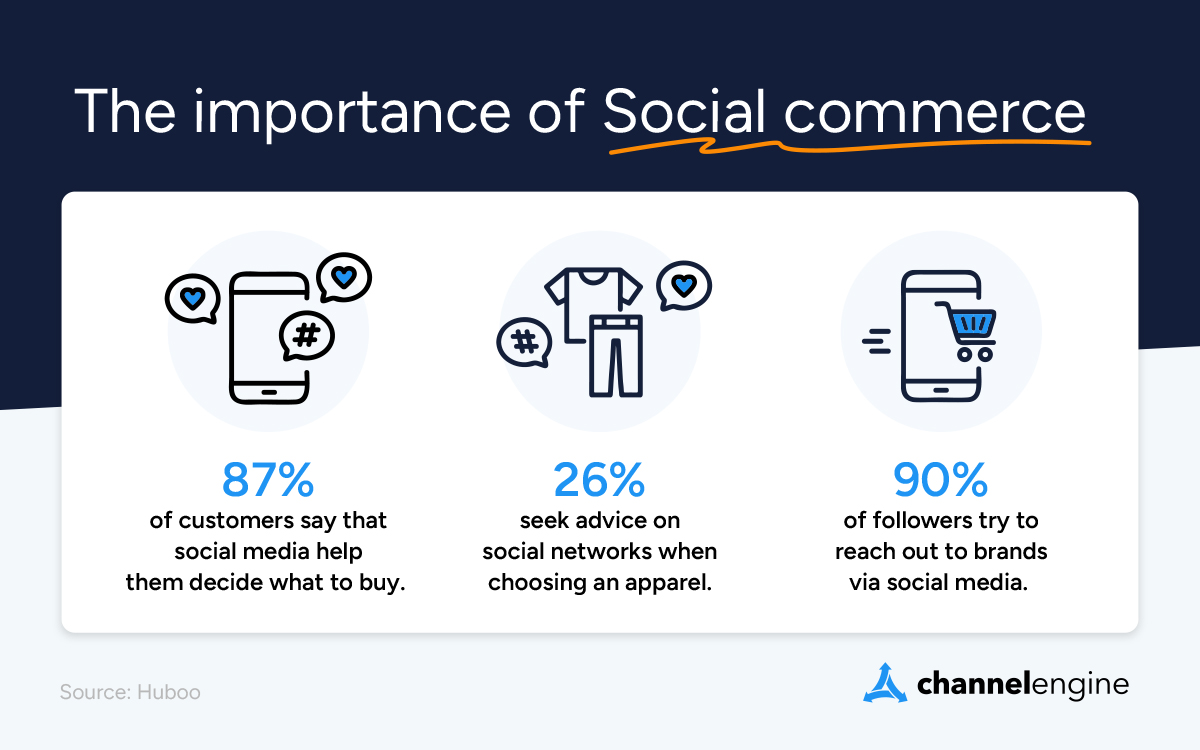Fashion ecommerce remains at the heart of modern retailing, and as we approach 2024's final quarter, it is worth reflecting upon its ongoing growth and transformation and our predictions for 2025.
Statista predicts that fashion ecommerce will experience a CAGR of 14.2% between 2017-2025, reaching an expected valuation of $1 trillion by 2024.
Clothing, footwear, and accessory sales figures have steadily increased worldwide, with US market sales reaching $224.0 billion by 2024, with a CAGR of 4.3% from 2024 to 2028.
As 2024 nears its conclusion, this article reflects on significant trends that have shaped fashion ecommerce throughout the year.
These advancements have not only transformed how consumers shop online but also empowered brands to adapt and thrive in a highly competitive digital landscape. The fashion ecommerce sector has witnessed groundbreaking changes in consumer expectations, technological innovation, and sustainable practices in 2024.
From the integration of AI-powered tools to the proliferation of resale marketplaces and the continued rise of social commerce, many fashion brands have leveraged these trends to stay relevant and competitive. Moreover, consumer demand for personalized shopping experiences and sustainable options has pushed businesses to evolve rapidly, cementing ecommerce as a cornerstone of the modern fashion industry.
Looking back, these developments have not only driven significant growth in the sector but also redefined how fashion brands connect with their audiences, positioning the industry for further transformation as we head into 2025.
Importance of marketplaces in fashion ecommerce
Marketplaces are unsung heroes of fashion ecommerce, quietly revolutionizing how brands connect with their audience and drive sales. When discussing fashion ecommerce trends for 2025, we must recognize marketplaces' vital role.
One of the primary drivers behind fashion marketplaces' rising prominence is their unparalleled reach. These platforms serve as hubs that draw millions of potential customers - an asset fashion retailers could leverage into increased sales and brand exposure.
Amazon has solidified its position as the leading apparel retailer in the U.S., with estimated sales surpassing $56 billion in clothing, footwear, and accessories in 2023, over 70% more than its nearest competitor.
This growth is significantly driven by third-party vendors, who contribute a substantial portion of the platform's apparel listings. In 2023, Amazon.com attracted approximately 2.2 billion monthly visits, underscoring the vast opportunities for brands to reach a wide audience through the platform.
Zalando, a Germany-based online fashion marketplace, achieved an impressive revenue of €10.1 billion in 2023. Operating across 25 European countries, Zalando's active customer base reached over 51 million in 2023 and continues to grow in 2024.
Marketplaces distinguish themselves by providing lower entry barriers into online retailing. Starting an independent store can be arduous and complex, filled with hurdles. However, marketplaces provide ready-made infrastructure, efficient payment systems and established customer bases - offering emerging fashion brands an easier path towards building their online presence.
The secondhand apparel market in North America continues to outpace the overall apparel market, with projections indicating it will reach $77 billion by 2028, and $350 billion globally. Marketplaces are a significant driver, with around 70% of consumers stating how it is far easier to shop secondhand than three or five years ago.
Vinted and Depop are growing P2P marketplaces for pre-owned items in Europe. Both are incredibly easy for sellers to start listing items, with app downloads in the millions.

Trust and credibility are hallmarks of online retail. Marketplaces have earned their stripes by adopting robust buyer protection policies that build shoppers' trust, prompting more to purchase brands featured within it - increasing sales while decreasing return rates for fashion retailers.
Marketplaces also serve as an avenue for global expansion. Fashion brands looking to enter new markets quickly can use marketplaces as an efficient means of entering them without incurring the expenses and complications associated with setting up a physical presence in each region. Asos is a prime example. It is one of the biggest fashion marketplaces in the world, offering products from nearly 900 partner brands alongside its own 13 in-house labels. The company ships to all 196 countries, utilizing fulfillment centers in the United Kingdom, the United States, and Europe to serve its global customer base.
Marketplaces provide valuable sources of data and insight, with information available about consumer behaviors and preferences known to be exploited to make more competent inventory management, pricing strategies, and marketing efforts decisions.
Customizing marketing and product offerings for fashion brands
Personalization is quickly becoming a key strategy in fashion ecommerce for increasing customer engagement and sales. Below are how some top fashion ecommerce brands use personalization to their advantage.
Fashion brands like Zara use data from their customers to personalize their strategies. Zara offers tailored product recommendations online and in stores by analyzing the customer's browsing and purchase history. This allows them to provide a more personalized shopping experience.
ASOS's dynamic content is a unique feature in the fashion ecommerce sector. It adapts its website content to customer behavior. ASOS will ensure that users are shown relevant content if they frequently search for men's formal clothing.
Amazon Fashion uses recommendation engines heavily. These algorithms analyze the user's activity to recommend clothing, shoes, and accessories that match their preferences and styles. This personalizes customers' shopping experience and leads them to products they will likely be interested in.
Urban Outfitters is a leader in cultivating user-generated content. It encourages its customers to upload photos of them wearing its products on social media platforms. These images are featured on Urban Outfitters' website, creating a sense of community and showcasing unique customer styles.
Gucci provides responsive customer support across multiple channels, such as chatbots and live chat. These AI-driven tools offer customized product recommendations, assistance with size queries, and real-time customer support.
Fashion brands use personalization as a critical strategy in ecommerce. They can boost customer engagement and loyalty by leveraging data and technology. These examples demonstrate how personalized shopping can create a more meaningful experience for the target demographic.
Selling through multiple channels in fashion ecommerce
Brands increasingly acknowledge the need to expand beyond a single digital platform and develop an omnichannel strategy comprising various digital and traditional channels. Such an integrated approach to fashion ecommerce success is indispensable.
1. Extending reach
Fashion brands can cast a wider net and expand their customer reach by selling across various channels. Whether through ecommerce websites, mobile apps, marketplaces, or brick-and-mortar stores - each channel presents an opportunity to connect with different customer segments.
2. Exceed customer expectations
Consumers today demand seamless and unified shopping experiences across channels. An integrated approach ensures customers receive consistent quality of service regardless of whether they shop online, on mobile apps, or at physical locations.
3. Establish trust and credibility
Being present on established marketplaces such as Amazon, eBay, or Etsy can help businesses build trust with customers by increasing the recognition and credibility of the brand in question. Customers tend to purchase more from an establishment they know and respect than one they don't recognize or trust.
4. Enhancing customer convenience
Offering multiple channels gives customers more choices to find what they want, from online browsing and checkout to trying in-store items before purchasing them online. With multiple channels catering to varied preferences, a company like ours provides customers with what they need.
5. Data-driven insights
With multiple channels producing valuable data that can inform decision-making, brands can tap into deeper insight into customer behavior, preferences, and trends by combining information from different sources.
6. Navigating market trends
Fashion ecommerce is ever-evolving, requiring brands to quickly adjust to shifting consumer tastes to stay ahead of the curve. An integrated ecommerce approach enables brands to pivot swiftly and stay current on changing consumer needs to remain at the cutting edge.
Social commerce in fashion ecommerce
Social commerce has been a transformative force in fashion ecommerce throughout 2024, revolutionizing how brands connect with audiences and drive sales. By seamlessly merging social media with online shopping, this platform has enabled fashion brands to thrive. Looking ahead to 2025, we expect social commerce to continue its rapid growth, offering even more opportunities for brands to engage consumers and build lasting connections.

Social commerce provides a seamless shopping experience by breaking down barriers between social media platforms and online stores. Customers can discover and purchase products without leaving their favorite social apps - increasing convenience while encouraging impulse buying.
Influencer marketing has quickly become an integral component of social commerce. Fashion brands enlist influencers and celebrities as partners to market their products through social media directly. Influencers provide authentic endorsements that resonate deeply with their followers, providing fashion brands with invaluable brand ambassadors.
The graphic below shows the top fashion brands mentioned by influencers on social media.
User-generated content is one of the hallmarks of social commerce. Customers engage in this form of customer-generated media by posting photos and reviews of purchased fashion products via platforms such as Instagram and Pinterest, providing valuable social proof. Such user-generated material influences potential buyers while simultaneously building community spirit.
TikTok has revolutionized social commerce through its short-form video format. Zara and H&M have harnessed TikTok's shoppable features to showcase their latest collections, directly linking users to their online stores.
Social commerce is no longer limited to one platform. Fashion brands diversify their strategies by exploring various options such as Instagram Shopping, Facebook Marketplace, and Pinterest Shopping to reach different demographics and markets while increasing online presence and potential sales. TikTok has shifted its focus to 'TikTok Shop,' integrating shopping features directly into the platform to enhance user experience and drive sales.
Ethical and sustainable fashion
Sustainable fashion is rooted in the principle of sustainable development, a concept the UN outlined back in 1987 as development that fulfills current needs without jeopardizing the ability of future generations to meet theirs.
The essence of “sustainable fashion” carries a noble intention. Advocates and experts use this term, along with others like ethical fashion, green fashion, and eco fashion, to push for an industry that respects our planet's limits and safeguards the welfare of people and animals across the supply chain.
True sustainability, in their view, demands a major overhaul of the business models that promote overproduction, overconsumption, waste, worker exploitation, and the climate crisis. Terms like degrowth and the circular economy often come up in discussions about the sweeping changes needed to create a genuinely sustainable fashion industry.
Ethical and sustainable fashion often get lumped together, but they each have their own flavor. For some folks, ethical fashion zooms in on the social side of things, zeroing in on what's "morally right."
Ethical fashion isn't just about playing by local labor rules. It digs deeper, tackling issues like fair wages, safe working conditions, animal welfare, and even vegan fashion. It’s about ensuring every stitch and seam respects both people and the planet.
AR technology and virtual try-ons
AR technology has revolutionized fashion e-commerce with highly realistic virtual try-ons. Brands like Zalando now use advanced AI-driven 3D avatars to help customers visualize garments accurately, reducing return rates and improving satisfaction (Zalando). AR adoption has grown significantly, with its ability to merge convenience, sustainability, and personalization, making it an integral tool for modern retail (SmartTek).
Some of the benefits for sellers on marketplaces:
- Increased Conversion Rates: AR enhances customer confidence in their purchases, leading to higher conversion rates. Shoppers are more likely to buy when they can visualize how items will look or fit.
- Reduced Returns: Accurate AR try-ons minimize the likelihood of size or style-related returns, saving sellers on shipping and restocking costs.
- Enhanced Customer Engagement: Sellers can attract and retain customers by offering immersive shopping experiences, boosting brand loyalty and satisfaction.
- Data-Driven Insights: AR tools generate valuable user interaction data, helping sellers refine inventory, pricing strategies, and product offerings based on customer preferences.
- Competitive Advantage: Early adopters of AR differentiate themselves on crowded marketplaces, drawing tech-savvy customers and setting themselves apart from competitors.
Flexible payment solutions in fashion ecommerce
As customers' preferences and financial needs shift, offering multiple payment solutions is crucial in driving sales growth and enriching the shopping experience.
Buy now, pay later (BNPL)
BNPL services have gained significant traction, allowing consumers to purchase items immediately and pay over time, often without interest. Platforms like Afterpay, Klarna, and Affirm have led this trend, making fashion more accessible and reducing cart abandonment rates. Notably, Frasers Group has integrated its Frasers Plus BNPL service into THG's Ingenuity ecommerce platform, highlighting the growing importance of flexible payment options in the industry
Image Source: prettylittlething
Credit cards
Traditional credit card payments remain a staple in fashion ecommerce, offering convenience and flexibility. Many consumers prefer this method to pay in full or to benefit from rewards and cashback programs. Secure payment gateways are utilized to ensure smooth and safe transactions.
Mobile wallets
The adoption of mobile wallets such as Apple Pay, Google Pay, and PayPal has increased due to their convenience and security. These options provide a contactless checkout experience, which has become particularly appealing in recent years. In markets like China, mobile wallets are especially popular, reflecting regional payment preferences.
For instance, in 2023, India led in digital wallet adoption with 90.8% of consumers, followed by Indonesia at 89.8%, and Thailand at 89.0%. In the United States, 46.7% of consumers used digital wallets.
Installment plans
Beyond BNPL services, some fashion brands provide installment plans that break down purchase prices into manageable installment payments. This approach enables customers to afford premium fashion items more easily, catering to a broader audience.
Cryptocurrency
Fashion ecommerce websites like Overstock and Shopify have recently shifted into accepting cryptocurrency as a payment option. This option appeals to tech-savvy consumers seeking alternative payment methods.
Luxury fashion brands such as Gucci, Balenciaga, and Off-White have also embraced cryptocurrency payments, showcasing a growing trend in the industry. These brands highlight how digital currencies are becoming an integral part of the fashion e-commerce ecosystem, catering to the preferences of a digitally-forward customer base.
Offering flexible payment options is crucial in satisfying fashion ecommerce customers' varying needs and preferences. From BNPL services that democratize luxury fashion to traditional credit card payments, mobile wallets for convenience, or cryptocurrency for tech enthusiasts - brands offering multiple payment solutions will enhance the shopping experience and drive sales.
Subscription models in fashion
A subscription business model is all about customers paying a recurring fee for access to a product or service. The key takeaway here is access, not ownership.
There are various flavors of subscription models:
- Access to content: This could be anything from a magazine, a website, a streaming service, an app, to a video game. Customers shell out a monthly or annual fee to dive into the content.
- Access to service: This subscription type offers access to a service, often bundled with a physical product. For instance, a customer might pay a monthly fee for a laundry service that includes pickup and delivery.
- Access to a product: Here, customers receive a physical product on a regular basis. Think subscription boxes – a relatively new trend where customers pay a monthly fee for a curated selection of goodies, be it makeup, clothes, or books.
- Product rental: Instead of buying, customers rent products. For example, they might pay a monthly fee to rent a designer handbag or a piece of exercise equipment.
A subscription business offers a golden advantage: recurring revenue. With customers committing to regular payments, brands can better predict revenue and demand. This model allows management to plan and invest with confidence. It’s a strategy that has thrived in the tech industry, so it’s no shocker that the fashion sector wants in on the action.
Subscriptions also unlock a treasure trove of consumer insights, enabling brands to predict and meet customer desires more accurately. Each box or service delivery helps brands learn likes and dislikes, refining and personalizing the shopping experience with the data collected.
Take Fabletics, a subscription-based activewear retailer, for example. They kick things off by gathering data on where the product is worn, consumer preferences, and vital fit stats. This info then guides product tweaks and recommendations.
All in all, the subscription model isn’t just about steady revenue – it’s about creating a tailored, data-driven experience that keeps customers coming back for more.
Concluding thoughts
As we look toward 2025, the fashion ecommerce landscape is poised for remarkable growth and innovation. From the integration of cutting-edge technologies like AR and AI to the rise of sustainable practices and flexible payment options, the industry is evolving rapidly to meet the changing needs of consumers.
Marketplaces, social commerce, and subscription models have transformed how brands connect with their audiences, while personalization and omnichannel strategies have redefined the shopping experience.
Fashion ecommerce is not just keeping pace with consumer demands but setting new standards for convenience, engagement, and sustainability.
The brands that embrace these trends and adapt to the dynamic digital landscape will be well-positioned to thrive in this competitive and ever-evolving market. The future is bright for those ready to innovate and lead in shaping the next era of fashion retail.





